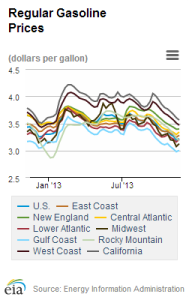
Many of the nation’s estimated 1,600 college newspapers are now experimenting with editorial and business innovations in the face of some of the same economic hardships that have hit the rest of the newspaper industry.
There is little hard data on the student newspaper field compared to that of the widely-studied commercial side, but these publications also struggle with issues ranging from the balance between print and digital to diminishing advertising revenue.
Like the beleaguered commercial newspaper industry which has tried a wide range of strategies to counter the long slide in revenue and readership, college newspapers also are coming up with new ways of addressing them:
- Reducing Publication Frequency. Many student papers have cut down on days of print publication as one cost-saving measure. In recent years, The Daily Orange at Syracuse University, The Daily Californian at UC Berkeley and the Minnesota Daily at the University of Minnesota all dropped one day of publication. Earlier this year, The Maneater at the University of Missouri went from publishing two days a week to just one. Even the Commonwealth Times at the Virginia Commonwealth University, which had expanded to a wide broadsheet and full-color format, decreased publication from twice weekly to weekly.
- New Revenue Streams. Meanwhile the search for new revenue is in full swing. Some papers, such as the 97-year-old Western Herald at Western Michigan University and the New University at UC Irvine got a boost after student bodies approved new fees to help subsidize the papers earlier this year. A few papers, such as the Daily Tar Heel at the University of North Carolina in Chapel Hill and the Daily Emerald of the University of Oregon, have garnered additional revenue by adding housing, restaurant or bar guides to their online editions, thus attracting advertisers.
- Fundraisers and Naming Opportunities. Still other student papers like The Daily Illini at the University of Illinois at Urbana-Champaign and The Southwestern College Sun in Chula Vista, California, have held fundraisers, concerts and banquets in the hopes of making enough money to support the paper. An alumni group worked to raise money for George Washington University’s Hatchet by offering naming opportunities for engraved plaques, offices, a staff lounge and an entire building.
- Digital First. In recent years, several schools have attracted attention for their adoption of a “digital first” strategy. At papers such as the University of Virginia’s Cavalier Daily and the University of Oregon’s Daily Emerald, this has translated into an expanded focus on web and mobile content accompanied by a reduced and sharply refocused print run. The University of Georgia’s Red and Black now puts breaking news online and publishes more enterprise stories such as profiles and investigative pieces in their weekly print edition.
- Digital Pay Plans. In 2011, Oklahoma State University’s Daily O’Collegian became the first college news outlet to experiment with a paid digital subscription program. It now has more than 400 subscribers. About 50 college newspapers have now joined the e-commerce platform Press+ to help generate donations or subscription revenue, targeting alumni and parents. Boston University’s Daily Free Press, for example, now uses Press+ to request tax-deductible donations.
The role of digital in the overall future of the nation’s college newspapers, however, remains an open question. A 2008 survey by Robert Bergland and David Hon of a random sample of 392 college newspapers revealed that over one third (36%) of them either did not have a website or that it was out of date. The results of a follow-up survey conducted in 2012 by Bergland, Hon and Rachele Kanigel and using the same list of college newspapers, revealed that almost the same percentage of papers (37%) still did not have a website four years later.
Note: An earlier version of this blog post incorrectly stated that the Commonwealth Times is the student paper of the University of Virginia. It is the student newspaper of the Virginia Commonwealth University.
